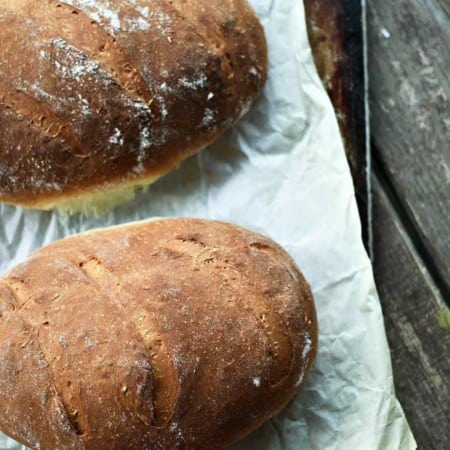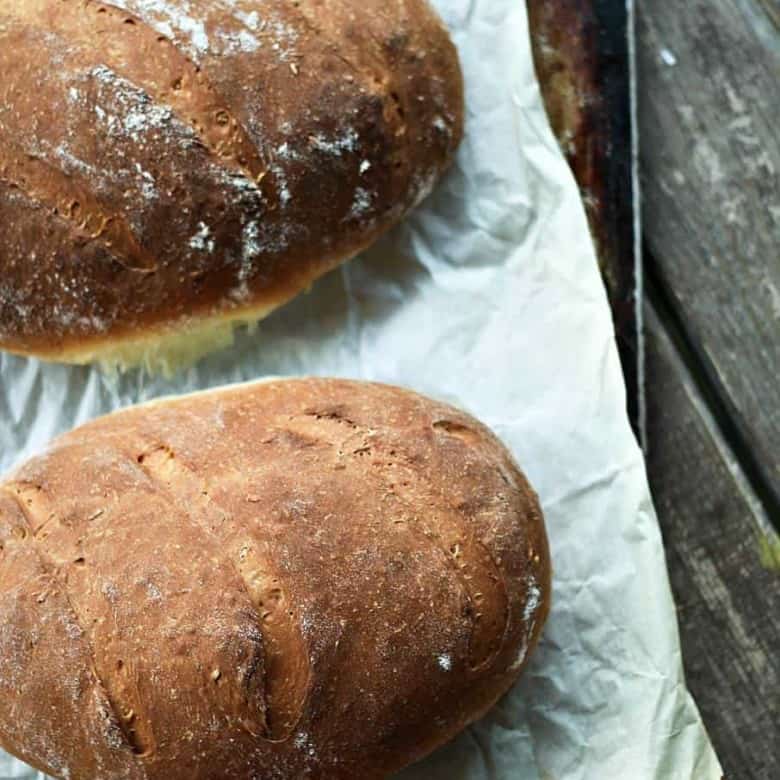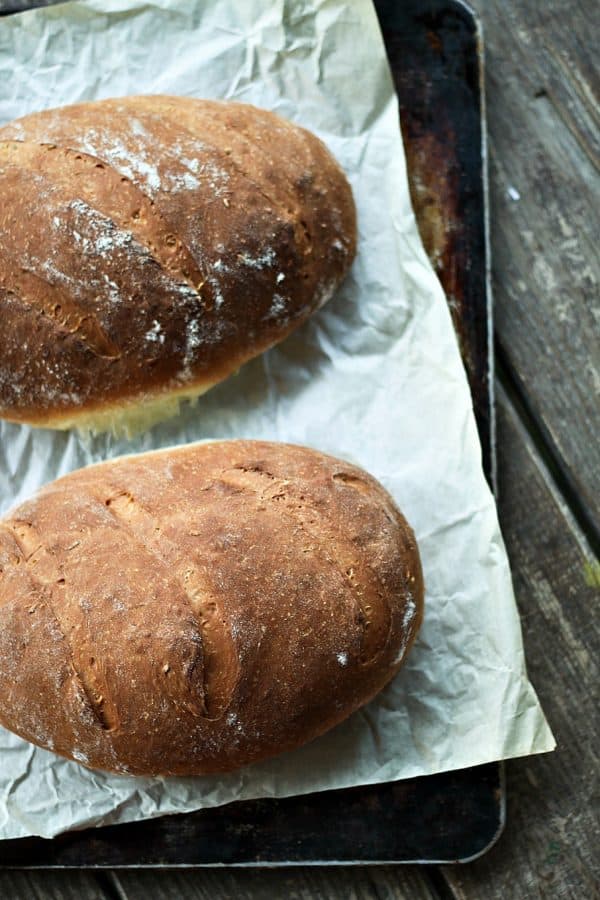Visit our Bread Recipes page for more wonderful homemade bread recipes!
This recipe was originally part of a guest post I did for my dear friend, Stephie. Please go show Stephie some love!
One-Hour Swedish Limpa Bread. This is the stuff on which dreams are made.
WHAT?!? No really. It’s a yeast bread that is done –start to finish- in a little under one hour. It’s not just any bread, though, oh no; it’s a lightning speed makeover of a classic Swedish rye bread that is lightly scented with orange zest and fennel seed. Please fire up your imagination and take a deep whiff of a piece of that bread lightly toasted in a frying pan with a little sweet butter. Maybe it’s just me, but my head gets all swimmy just pretend-smelling that. When I take it a step further and slather the bread with preserves or jam, I get borderline weepy. “What the heck? Who knew she was so loopy?” In my defense, I have just two words to share: FRESH BREAD.
Between Doctor Atkins and the explosion of Paleo diets, bread has taken a serious beating in the court of public opinion. We all know that bread is still the staff of life, though, right? As in “Give us this day our daily?” There is nothing- NOTHING- in the world that beats the aroma of bread baking in the oven. Okay, there’s one thing that’s better… It’s that same aroma connected to bread that takes one hour from the time you start mixing things together until the time it comes out of the oven. That means you can have a last minute loaf of bread to accompany soups and stews, or take to a dinner party.
Let me throw a few cook’s notes your way to help you along with the process, and then we’ll slice up this bread,and let some cold butter melt its way over the warm surface, and feel pretty good about ourselves and the world in general.
Cook’s Notes
- I prefer to make this bread using my stand mixer, but I know that isn’t something everyone has, so the recipe includes instructions for making by hand, with a food processor, and with a stand mixer.
- Line your pan with parchment or a silpat. There isn’t much sadder than trying to pry a loaf of fresh, soft, lovely bread off of a pan to which it’s become thoroughly cemented.
- I like to form this loaf in a non-traditional oval shape. I find the oval shape works better for slicing and toasting uniform pieces. You like rounds (boules) better? No problemo! Make it round!
- The reason we slash the top of the bread is to let steam escape from the inside without mangling the shape of the loaf. Steam has to find a place to get out, and if we don’t provide that, it’ll blow a hole somewhere. If you’re shooting for uber-rustic, go for it. Call me a control freak, but I kind of like to make pretty bread, so I make the path for the steam.

One Hour Swedish Limpa Bread {orange and fennel scented rye}
Rate RecipeIngredients
- 5 cups all-purpose flour 1 pound, 9.5 ounces by weight
- 1 cup medium rye flour 3 5/8 ounces by weight
- 2 Tablespoons instant yeast also known as Bread Machine Yeast
- 1 Tablespoon Kosher salt if using table salt, reduce to 1 1/2 teaspoons
- The zest of one orange
- 1 tablespoon fennel seed toasted
- 2 cups very warm water about 120°F
- 2 Tablespoons butter
- 2 Tablespoons molasses
Instructions
Mixing the dough by Stand Mixer (my preferred method):
- Combine the flour, yeast, salt, orange zest, and fennel seed in the bowl of the stand mixer that has been fitted with a dough hook. Mix on low speed for 30 seconds.
- With mixer running, slowly pour in the water, molasses, and add the butter at the same time. Continue mixing on low until the dough comes together and becomes smooth, about 4 minutes. Remove bowl from the stand mixer, scraping any dough that remains on the dough hook into the bowl. Pull dough from bowl with your hands and form a smooth dough ball. Replace in bowl, cover with a clean tea towel and let rise in a warm place for 15 minutes.
Mixing the dough by Food Processor:
- Combine the flour, yeast, salt, orange zest, and fennel seed in the bowl of a food processor that has been fitted with a blade or dough blade. Pulse 10 times. With the food processer running, slowly pour in the water, molasses, and add the butter at the same time into the feed chute. Continue processing until the dough forms a cohesive ball. Spin the dough ball 20 times and shut off the food processor. Remove the dough, form a smooth dough ball and place in a lightly oiled mixing bowl. Cover with a clean tea towel and let rise in a warm place for 15 minutes.
Mixing the dough by Hand:
- Combine the flour, yeast, salt, orange zest, and fennel seed with a whisk or fork in a large mixing bowl. Slowly pour in the water, molasses, and add the butter into the flour mixture and use a sturdy spoon to combine into a shaggy dough. Use your hands to knead for 8 minutes*. After kneading for 8 minutes, cover the bowl with a clean tea towel and let rise in a warm place for 15 minutes.
- *If you find it difficult to knead in the bowl, you can turn the dough out onto a clean surface to knead it. After kneading, just return the dough to the bowl and allow it to rise as instructed above.
To Shape The Loaves:
- Turn dough out onto a clean surface and divide in half. Dust your hands with flour and form each half into an oval or a ball, pulling the edges down from the top and tucking under the loaf and place 5-6 inches apart on a baking sheet that has been lined with parchment paper or a silpat, or has been lightly greased. Use a sharp knife to slash the top of the loaf about 1/4 of an inch deep. This allows the steam to escape the baking loaf.
To bake the loaves:
- Arrange the racks in your cold oven so that one rack is on the very bottom and one is positioned in the center of the oven. Place the baking sheet with the loaves on the center rack and a bread or cake pan that is full of very hot tap water on the bottom rack. Close the oven and turn your oven on to 400°F. It is imperative that you start this in a cold oven! Set your timer for 40 minutes. That 40 minutes is all that stands between you and fresh bread.
- The crust should be a deep brown and quite firm when you remove the loaves from the oven. Transfer the loaves to a rack to cool completely if you wish to slice them, or you can do like I normally do and cool one loaf while tearing the second one into pieces and slathering with cold sweet cream butter.
Nutritional information is an estimate and provided to you as a courtesy. You should calculate the nutritional information with the actual ingredients used in your recipe using your preferred nutrition calculator.
did you make this recipe?
Make sure to tag @foodiewithfam on Instagram and #hashtag it #foodiewithfamily so I can check it out!
This is my eighth post in my commitment to post every. single. day in November for NaBloPoMo (National Blog Posting Month). Follow the craziness all month as I share recipes, family anecdotes, and throw a couple of giveaways in for good measure!





Reader's Thoughts...
Mary says
This is like a Christmas miracle! Easy. Worked like a charm and the taste was subtle and complex. Made it twice this week .
Rebecca says
Oh Mary! Thank you so much for taking the time to rate the recipe and let me know you love it!
Hanna says
This didn’t work for me, at all! I even made two batches but neither worked out despite following the directions perfectly. It didn’t brown up like it is supposed to. Kinda tastes like limpa? I dunno. Kinda bummed.
Rebecca says
Hi Hanna- I wish I could be there to figure out what went wrong for you. Have you tested your oven temperature lately? Did you accidentally use light rye instead of medium rye? The molasses should have helped your crust brown up nicely, if everything else was right.
Sara Debono says
I have been lpoking for rye bread started in cold oven that I used to make in the sixties. Thank you! Let me be sure. Is it asingle fifteen minute rising??? Can’t wait to try. Sally
Rebecca says
Hi Sally- You are correct; it is a single fifteen minute rise on the dough!
Sally Debono says
Finally had a chance to try. Made dough in my bread machine—initially just enough for one loaf. Looks great and am waiting for it to cool so I can slice and taste. I did slash the top in three places prior to putting in to bake. If I can figure out how to send photo, I will. Color is great and crust will be good—I can tell. Sally
Moni says
Thanks for sharing this wonderful recipe. I’ve made this twice in two days now. I used the juice from the zested orange in place of some of the water, but otherwise followed the recipe exactly. Love the orange scent with the fennel, and the bread had a really nice texture. I’m looking forward to trying it with caraway and maybe cardamom, too. Next batch, we might even hold back a slice or two for toasting. Thanks again.
Sadie says
Excellent! I was skeptical that the taste and texture of this bread may be compromised because of the short rise but it delivers on both counts. The crumb is soft, moist and slightly open. The taste is amazing. It’s great plain or toasted. I halved the recipe and made 1 loaf as a test loaf. I didn’t make any significant changes to the recipe, but I did use 1 cup of rye flour and 2 cups all-purpose flour, which may have slowed down the rise. At 15 minutes the dough hadn’t shown much of a rise, so I let it sit for 30 minutes until it was puffy. I used a stand mixer to knead the dough and kneaded until it passed the windowpane test, which took about 10 minutes. I added 2 tbsp of orange juice concentrate to the water, and 1 tsp each of anise and caraway seeds. The aromatics were all well balanced. I shaped the dough into an oval loaf, and baked it uncovered, in a clay baker lined with parchment paper. Bake time was 45 minutes.
Sandra Tatsuno says
Hi! Growing up Swedish, limpa was always a staple in our house. So excited to try this 1 hr. version! My mother’s recipe, however, calls for equal amounts rye and APF, and orange juice instead of water (same amount), Would that work with this recipe? Thanks!
Rebecca says
Hi Sandra-
I would definitely feel comfortable saying the orange juice in for the water would be fine, but I’m a little more hesitant to recommend doing equal parts rye and all purpose flour because rye is a whole grain and when you get into half and half ratios, you’ll need a longer, slower rise time to accommodate those whole grains!
Sandra Tatsuno says
Thanks Rebecca! And yes, you’re right about the longer rising time needed for the rye flour! Didn’t think of that. Will let you know how it turns out. Making it this morning! Thanks again!
Jan T-Cameron says
When I saw this recipe, I knew I had to make it. I did, however, substitute 2 cups of warm beer for the warm water. I like to use regular loaf pans which I line with parchment. I divided the dough into 4 pieces, put two rounds in each pan, sliced the tops as instructed, and otherwise followed the instructions. After toasting the fennel seeds I ground them before adding them to the flour mixture. I guess I should also confess, I use orange oil instead of zest of orange. If one has all the ingredients measured and ready to go, this would bedone in the allotted time. I think it took me closer to 2 hrs; however, no complaints! Great recipe, and I will definitely be making it again in the not too distant future.
Katrina @ Warm Vanilla Sugar says
One hour?!? Whaaaaat?? This has skyrocketed to the top of my must make list!! Yum!!
Crystal | Apples & Sparkle says
Freshly baked bread is the best stuff in the world!
Nancy Long says
Oh my heaven, can’t wait to make this – I can almost smell it – think I have everything I need for it, but will check freshness of my fennel seed. There’s only the two of us, but my neighbors always benefit from my baking. Just took French bread out of the oven
Rie says
I’ve had my eye on this recipe for a while. Thanks for the push to try it.
Millie | Add A Little says
This sounds so wonderful – I find it super rewarding to make my own bread and this seems amazing!
Julie says
We loved this bread!! As in, we devoured it immediately. I did half the recipe, since it’s just the two of us, and it worked beautifully. Yum!